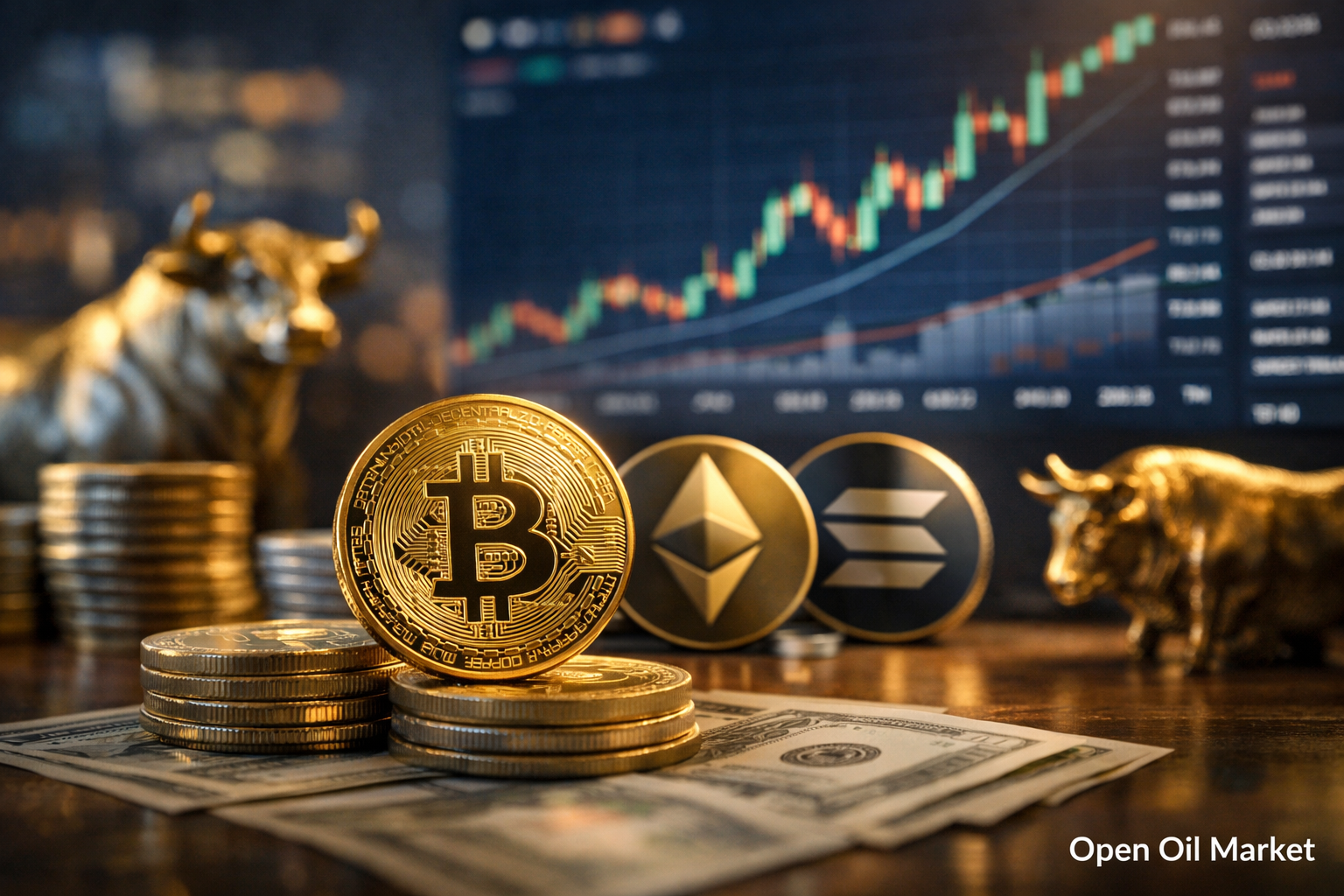
Detailed Overview of Economic Events and Corporate Reports for October 18, 2025: Outcomes of the G20 Meeting, Expectations for China’s GDP Data, Commodity Market Dynamics, and Corporate Reports from the USA, Europe, Asia, and Russia.
The weekend sets a relatively calm agenda for the markets: no official macroeconomic publications are scheduled for October 18, placing global factors at the forefront of investor attention. Globally, discussions focus on the outcomes of the G20 finance ministers' meeting and the prospects for the world economy; in Asia, the spotlight shifts to the upcoming GDP data for China for Q3. The energy sector is monitoring oil prices, which have fallen to near lows amid expectations of oversupply, while the gas market remains stable ahead of the winter season. On the corporate side, the quarterly earnings season is underway: in the USA, attention is shifting from bank results to tech giants, while initial releases from luxury and tech sectors in Europe set the tone, and major chipmakers in Asia report encouraging results. It is crucial for investors to assess global trends as a whole: economic growth rates ↔ central bank policies ↔ corporate profits ↔ commodity prices ↔ overall risk appetite in the markets.Macroeconomic Calendar (Moscow Time)
- Weekend – no key macroeconomic indicators are scheduled for release.
Global Economy: Outcomes of the G20 Meeting
- Resilience and Risks: The recently concluded G20 meeting highlighted the overall resilience of the global economy in the first half of 2025, although a number of ongoing risks were underscored. Key threats include geopolitical tensions, vulnerabilities in supply chains, high debt levels in several countries, and climate factors. Despite these challenges, financial leaders expressed confidence in the capacity of the global economy to avoid recession with appropriate policies.
- Macro Policy and Debt: G20 participants consensus highlighted the importance of stimulating macroeconomic policies for maintaining long-term growth. A specific emphasis was placed on addressing high government debt levels: governments must seek a balance between fiscal sustainability and incentives. Transparency in debt obligations and expanded cooperation with international financial organizations (IMF, World Bank) were recognized as priorities for reducing crisis risks in emerging markets.
- Development Institution Reforms: The meeting's final summary emphasized support for reforms of multilateral development banks aimed at increasing their lending capacity. There are proposals to involve emerging economies more actively in decision-making processes to expand access to infrastructure and sustainable project financing. The G20 aims to ensure that international financial institutions respond more effectively to global challenges and provide resources to emerging market countries.
China: Economic Growth Under Close Watch
- Expected Slowdown: China is set to publish GDP data for Q3 2025 early next week (October 20). Analysts forecast growth of around 4.5%–5.0% year on year, somewhat below the previous quarter’s figure of 5.2%. This potential slowdown is attributed to a high base effect from last year and ongoing difficulties in certain sectors, primarily real estate and exports.
- Factor Balance: Domestic consumption in China remains the primary growth driver, aided by stimulus measures and improvements in the labor market. However, investment activity is declining: the construction sector is experiencing a contraction, and private companies are cautious due to regulatory measures. External demand is also weakened by economic slowdowns in Europe. At the same time, the high-tech sector (e.g., chip and electronics manufacturing) displays strong growth supported by government programs and global AI product demand.
- Market Impact: The Chinese GDP data will serve as an indicator for global commodity and equities markets. A stronger-than-expected growth could support prices for industrial metals, oil, and emerging market assets, signaling robust demand. Conversely, disappointing statistics could intensify discussions about additional stimulus from the People's Bank of China and the Chinese government, which may temporarily increase volatility in the yuan and commodities currencies (AUD, NZD), but also foster hopes for more stimulus, mitigating negative impacts.
Energy Markets: Oil at Lows, Gas Stable
- Oil - Oversupply Risk: Brent oil prices are holding near multi-month lows (around $60–65 per barrel) due to expectations of oversupply by year-end. The OPEC+ alliance confirmed its planned slight increase in production from November (~+130 thousand barrels per day) during its early October meeting, returning previously restricted volumes to the market. However, global demand is growing slower than expected: the International Energy Agency (IEA) has lowered its estimate for 2025 demand growth (~0.7 million barrels per day against previous expectations of ~0.74 million) amid slowdowns in European and Chinese economies. Meanwhile, production outside OPEC (USA, Brazil, Guyana, etc.) is increasing at a faster pace. Consequently, some analysts warn of a potential return to oil oversupply in Q4, which is exerting downward pressure on prices.
- Gas - Comfortable Stocks: The situation in the gas market is favorable for consumers. The EU is entering winter with record gas reserves: underground storage is over 95% full on average across the EU. Thanks to mild autumn weather and stable LNG supplies, wholesale gas prices in Europe remain low (benchmark TTF futures around €30 per MWh, significantly lower than peaks in autumn 2022). The high level of reserves sharply reduces the likelihood of a repeat of last year's price shock even in the event of colder weather. For Russia, the reallocation of gas exports to the East (increased supplies to China via "Power of Siberia," expanding LNG exports) partially compensates for the decline in sales to Europe; however, overall exports still lag behind pre-sanction levels. Stable gas prices mean reduced inflationary pressure on the European economy and provide breathing room for industrial consumers ahead of the winter season.
- Geopolitics and Sanctions: Risks of unexpected shocks in energy markets remain. Sanction pressure on the Russian oil and gas sector continues to grow: Western countries are discussing new restrictions (e.g., an embargo on the purchase of Russian LNG by 2026), which could alter global supply configurations in the future. For now, shadow redistribution of flows (discounted oil sales to India, China, and the Middle East) allows Russia to maintain most of its export volume, even if at the cost of discounts. Additionally, geopolitical factors remain a safeguard for the market: any escalation in the Middle East or new incidents involving energy infrastructure (such as drone attacks) could quickly reinstate the "risk premium" in oil prices despite the current bearish sentiment.
Other Regions and Indices: S&P 500, Euro Stoxx 50, Nikkei 225, MOEX
- S&P 500 (USA): The earnings season in the USA is gaining momentum. The first wave of results from major banks showed a mixed picture: record profits from interest income amid high rates (some banks, such as **JPMorgan**, exceeded expectations) but weakness in investment banking. **Morgan Stanley** stood out with a surprising revenue growth and strong wealth management results, supporting stocks in the financial sector. Upcoming are reports from tech leaders: next week investors await results from **Netflix**, **Tesla**, and other “big tech” companies, which could set the market tone. High expectations for the AI sector have already led to excellent results from chipmaker **TSMC** (profit growth and raised guidance amid heightened demand for AI equipment). Now, focus shifts to forecasts from American IT giants; if revenue and margins continue to grow, it could divert market attention from macroeconomic risks.
- Euro Stoxx 50 (Europe): European "blue chips" are just entering the active phase of Q3 earnings reports. Several early releases have instilled optimism: French conglomerate **LVMH** reported a revival in sales (+1% organic growth in Q3 due to demand recovery in China), triggering a rally in luxury sector stocks. Dutch chip lithography manufacturer **ASML** also reported better than expected and maintained a positive demand outlook, citing a “chip boom” for AI. Nevertheless, overall economic conditions in Europe remain challenging: high rates and inflation are pressuring construction and retail sectors, so market participants are closely watching upcoming reports from banks (such as **Deutsche Bank**, **Santander**) and automakers at the end of October. Their results and demand commentary will indicate how well the eurozone economy is coping with a prolonged period of expensive money.
- Nikkei 225 (Japan): Japan is in the midst of the corporate earnings season for the first half of the 2025 financial year (April–September). A series of releases from industrial giants and consumer firms is anticipated. The yen's weakness against the dollar (USD/JPY approaching 150) may have supported export-oriented industries, enhancing the competitiveness of Japanese goods abroad, as well as yielding currency revenue. Investors will watch for results from automakers (such as **Toyota**, **Honda**) and electronics companies for export profit growth. Domestic demand in Japan is showing moderate recovery thanks to rising wages and government stimulus, which may reflect in retailer reports. Overall, corporate profits in Japan are expected to have risen by single digits on average, confirming the economy's gradual exit from a deflationary scenario.
- MOEX (Russia): The Russian market is concluding its period of operational results release for the summer months. Companies in the transportation and energy sectors have reported Q3 data: for instance, airline holding **Aeroflot** reported a decline in passenger traffic over the summer amid high base effects from last year, while several oil and gas companies reported stable production despite export restrictions. In retail, there is differentiation: food chains continue to grow revenue at double-digit rates, whereas non-food retailers are feeling a cooling in consumer demand. The main wave of financial reports for the first nine months is expected closer to November, and investors are already pricing in potential dividend surprises. The external backdrop (fluctuations in oil prices, the ruble’s exchange rate at around 80–85 against the dollar) remains a crucial factor for the Russian stock market. The MOEX index remains within range as the influx of domestic liquidity and strong results from specific exporters offset the geopolitical risk premium.
Daily Summary: What to Pay Attention to as an Investor
- Global Signals: The G20 summary underlined both the resilience of the global economy and the presence of risks (debt, conflicts). For investors, this suggests that the macro outlook remains uncertain. Attention should be paid to central banks' rhetoric: any hints at tightening policy or, conversely, readiness to support the economy could significantly alter market sentiment, especially amid high global indebtedness.
- Data from China: The upcoming GDP statistics from China could become the main driver at the start of the new week. If growth slows more than expected, there could be a short-term drop in prices for oil, metals, and currencies of emerging countries. However, strong data could support stocks of commodity companies and Asian markets. Investors focused on EM assets should be prepared for increased volatility around the release of these figures and hedge risks if necessary (e.g., through futures or options strategies).
- Oil Prices: The decline in oil prices to yearly lows is a factor that can both help and harm portfolios. For oil importers (airlines, chemicals, transport), this is positive due to reduced costs. However, low oil prices can exert pressure on the energy sector and commodity currencies (rubles, Canadian dollars, Norwegian kroner). Investors are advised to assess the share of energy assets in their portfolio: it may be wise to temporarily reduce exposure to oil and gas or shift to companies with more predictable margins. Monitoring OPEC+ statements is also important – if prices fall too sharply, the alliance may hint at a corrective adjustment in production plans, which could quickly reverse market trends.
- Corporate Reports: The earnings season could shift market focus from macroeconomic concerns to corporate narratives. In the upcoming sessions, results from American tech giants will take center stage – their forecasts on demand, profits, and margins will set the tone for the technology sector worldwide. For European investors, evaluating the reports from banks and industrial leaders regarding income resilience amid eurozone stagnation conditions is crucial. In Russia, attention is drawn to exporters’ dividend plans following the first nine months: any positive surprises could attract additional capital inflows to the local market. Overall, it is a good time to reassess individual stocks in the portfolio: whether to hold shares whose fundamentals are deteriorating, or better to redistribute funds into sectors benefiting from current trends (e.g., growth favorites in AI demand, or defensives with high yields).
Markets on October 18, 2025: Cryptocurrencies, Commodities, and Currencies
Cryptocurrencies: Bitcoin (BTC/USD) is consolidating around the $120,500 mark, gaining +1.2% over the last day. The benchmark cryptocurrency is maintaining levels close to historical highs, demonstrating relative stability against declining volatility. Ethereum (ETH/USD) is trading near $7,500, virtually unchanged for the day. The total market capitalization of crypto assets stands at $3.3 trillion, with sentiment indicators pointing to moderate optimism among investors in digital assets.
Stock Indices and Futures:
- Shanghai Composite: 3,610.45 (−0.42%)
- Hang Seng Futures: 24,730.0 (−0.68%)
- Nikkei 225 Futures: 43,800.0 (+0.20%)
- Euro Stoxx 50 Futures: 5,480.0 (+0.35%)
- S&P 500 Futures: 6,512.50 (+0.15%)
Commodity Prices:
- Brent Oil: $63.10/barrel (+0.10%)
- Natural Gas (Henry Hub): $3.105/MMBtu (−0.05%)
- Gold: $3,350.50/ounce (−0.40%)
- Silver: $37.50/ounce (−1.12%)
- Copper: $4.500/pound (+0.20%)
- Nickel: $1,280.0/ton (−0.50%)
- Aluminium: $2,600.0/ton (+0.30%)
Forex Market:
- EUR/USD: 1.1650 (+0.02%)
- GBP/USD: 1.3455 (+0.17%)
- USD/JPY: 150.10 (+0.08%)
- USD/CAD: 1.3760 (−0.05%)
- USD/CHF: 0.8180 (+0.10%)
- AUD/USD: 0.6430 (−0.05%)
- NZD/USD: 0.5925 (−0.20%)
- EUR/GBP: 0.8660 (−0.15%)
- GBP/JPY: 202.20 (+0.10%)
Yuan and Ruble Exchange Rates: USD/CNY — 7.250; USD/RUB — 82.50. The dollar/ruble pair has slightly strengthened compared to early month levels, reflecting declining oil prices and reduced demand for risk assets. Nevertheless, the ruble remains significantly stronger than during summer peaks, supported by high domestic interest rates and export earnings in foreign currency.
Analysis: Global markets show mixed dynamics over the weekend: US and European futures are moderately up, buoyed by optimism surrounding corporate results, while Asian indices are partially down due to concerns about China's growth rates. Oil prices remain under pressure from oversupply prospects, curbing commodity sectors and exporter currencies. Gold, which reached new highs in previous weeks, retreated below $3,400 per ounce due to persistently high real bond yields, as investors take profits from safe-haven assets. The currency market is relatively calm: the US dollar is consolidating following recent strengthening, while the euro and yen show slight gains as US Treasury yields decline from recent peaks. Overall, investor sentiment is neutral: the market awaits new triggers (such as statistics from China and reports from top companies) to determine the future direction of movement. For now, participants prefer not to make sharp moves, maintaining balanced positions and carefully analyzing incoming information.




